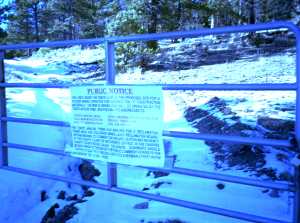Essay by Matt Hudson
Rural Life – May 2002 – Colorado Central Magazine
I WAS RAISED IN WESTERN Colorado and I have always loved the ranches in this part of the state. You know the type — somewhat run down, with a modest home and a tired barn plus a scattering of outbuildings. Sometimes there’s an original log homestead near a newer, (though still old) larger house. Broken or obsolete farm equipment usually completes the scene. Most of these ranches have been in the same family for generations.
As I grew up I came to admire and respect the people who own and operate these ranches. They are populated by grizzled, weather-beaten men and their families. The men have hard, scarred hands, and invariably wear sweat-stained Stetsons, impossibly dirty and battered. They work harder than anyone I have ever known, toiling their lives away 24/7 (long before it became a trite Yuppie phrase). And they keep working and feeding America, regardless of the weather, the season, the time of day, or what time “Friends” comes on.
My favorite part of ranching is what I call the Genuine Colorado Ranch Truck. Many readers may instantly recognize what I’m talking about — a full size, American-made, four-wheel-drive truck with few or no options. Some of the more successful ranchers have outfitted theirs with aftermarket flatbeds.
A truck like this perfectly captures Colorado ranching for me, with nary an un-dented piece of sheet metal on its body. Such a truck looks as though it may not have been washed since the ol’ boy first drove it off the lot.
This truck may have farm plates with the old two letter county prefix and a number below 1000, mute testimony of the owner’s time here. It has mud and snow tires, with at least one hubcap missing. The windshield has an obligatory crack and the plastic grillwork has been broken off.
A gun rack usually adorns the rear window, sometimes with a coiled lariat dangling off one hook. There’s often a rifle there, too, for eliminating “them damn coyotes.” And there may be a round NRA sticker in the corner.
The tailgate won’t quite close on one side, or it may be gone altogether. The bumper is dented or twisted or both. Said bumper usually has a bumper sticker saying “Eat Colorado Beef” or “Ask First to Hunt or Fish on Private Property.” And there may be a faded sticker showing support for a favored candidate for County Commissioner.
A few strands of orange bailing twine and some pieces of hay dangle in the gap between the tailgate and the bed. The rear wheels are flanked by “Colorful Colorado” mudflaps. Cow manure and mud adorn the sides.
If I ever had the time, I’d like to spend a year photographing these trucks in their natural habitat for a calendar. I’d shoot a winter scene of eager white-faced cattle following such a truck through the snow as forks of hay are strewn behind. In the cold gray light before sunup there would be steam coming from the tailpipe and the nostrils of the hungry cows.
In the spring I’d shoot a truck with chains on all fours, parked in the mud at a wire gate out in a field somewhere with the Sawatch Mountains in the distance. In the summer I’d catch one parked near a faded John Deere bailer, pausing momentarily during the first cutting of hay. Maybe there’d be a saddled horse tied to its bumper. Or maybe I’d take a picture somewhere along an irrigation ditch with a rancher in waders standing nearby with his shovel. In the fall I’d like to have a photo of a truck trailing a herd of cattle out of the high country with golden Aspen trees all around.
MORE AND MORE there are fewer and fewer of these trucks and the ranches that make them necessary. Along life’s way I’ve lived or worked extensively in many of our traditional ranching communities: Kremmling, Carbondale, Collbran and Meeker are just a few of the towns I’m familiar with.
My wife’s family once owned a ranch just outside Carbondale, but it was sold when the family patriarch became too old to run it. That ranch had a couple of worn Ford pickups toward the end, referred to simply as “the green truck” and “the brown truck.” Now, the ranch is slowly being cut into smaller and smaller pieces like so many others.
And some ranches are being bought by so-called “gentlemen ranchers.” These ranches are readily identifiable by their lavish entrance gates and split rail or even welded steel fences — fences that no real rancher could ever afford.
But I take heart in the fact that you can’t drive into Gunnison on a Saturday morning without seeing four or five examples of a Genuine Colorado Ranch Truck. They’re at the post office or the hardware store or the feed shop. They don’t linger long in those places though; these men always have more to do than they can possibly get done on any given day.
I don’t think my calendar idea would sell many copies. Too many of Colorado’s new residents simply can’t relate to that way of life. And the number of families who appreciate tough, old, reliable working trucks are dwindling. But I’d like to think there’s still some ranch families who’d want to have one of my calendars hanging in their kitchen.
Matt Hudson now lives in Crested Butte. He’s a photographer, and this is his first published piece of writing.

